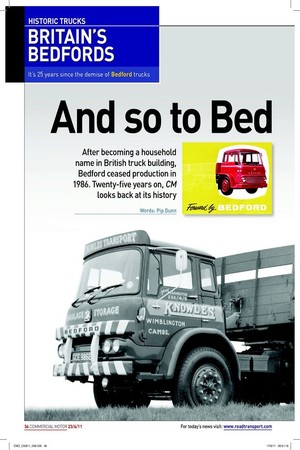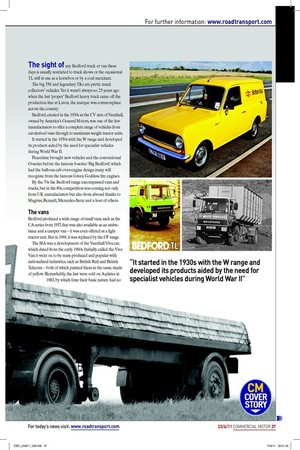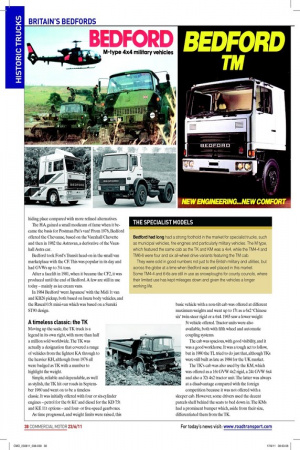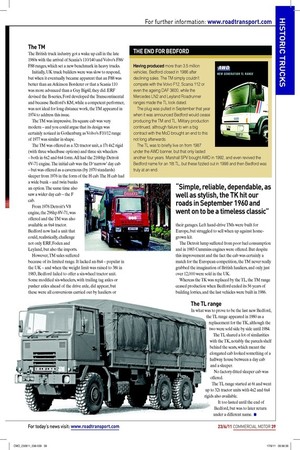And so to Bed
Page 30

Page 31

Page 32

Page 33

If you've noticed an error in this article please click here to report it so we can fix it.
After becoming a household
name in British truck building, Bedford ceased production in 1986. Twenty-five years on, CM looks back at its history Words: Pip Dunn The sight of any Bedford truck or van these days is usually restricted to truck shows or the occasional TL still in use as a horsebox or by a coal merchant.
The big TM and legendary TKs are pretty much collectors’ vehicles. Yet it wasn’t always so; 25 years ago when the last ‘proper’ Bedford heavy truck came off the production line at Luton, the marque was commonplace across the country.
Bedford, created in the 1930s as the CV arm of Vauxhall, owned by America’s General Motors, was one of the few manufacturers to offer a complete range of vehicles from car-derived vans through to maximum weight tractor units.
It started in the 1930s with the W range and developed its products aided by the need for specialist vehicles during World War II.
Peacetime brought new vehicles and the conventional O-series before the famous S-series ‘Big Bedford’, which had the bulbous cab-over-engine design many will recognise from the famous Green Goddess ire engines.
By the 70s the Bedford range encompassed vans and trucks, but in the 80s, competition was coming not only from UK manufacturers but also from abroad thanks to Magirus, Renault, Mercedes-Benz and a host of others.
The vans
Bedford produced a wide range of small vans, such as the CA series from 1957, that was also available as an ambulance and a camper van – it was even offered as a light tractor unit. But in 1969, it was replaced by the CF range.
The HA was a development of the Vauxhall Viva car, which dated from the early 1960s. Initially called the Viva Van it went on to be mass produced and popular with nationalised industries, such as British Rail and British Telecom – both of which painted them in the same shade of yellow. Remarkably, the last were sold on A-plates in 1983, by which time their basic nature had no hiding place compared with more reined alternatives.
The HA gained a small modicum of fame when it became the basis for Postman Pat’s van! From 1976, Bedford offered the Chevanne, based on the Vauxhall Chevette and then in 1982 the Astravan, a derivative of the Vauxhall Astra car.
Bedford took Ford’s Transit head-on in the small van marketplace with the CF. This was popular in its day and had GVWs up to 31/4 tons.
After a facelift in 1981, when it became the CF2, it was produced until the end of Bedford. A few are still in use today – mainly as ice cream vans.
In 1984 Bedford ‘went Japanese’ with the Midi 1t van and KB26 pickup, both based on Isuzu body vehicles, and the Rascal 0.5t mini-van which was based on a Suzuki ST90 design.
A timeless classic: the TK
Moving up the scale, the TK truck is a legend in its own right, with more than half a million sold worldwide. The TK was actually a designation that covered a range of vehicles from the lightest KA through to the heavier KH, although from 1976 all were badged as TK with a number to highlight the weight.
Simple, reliable and dependable, as well as stylish, the TK hit our roads in September 1960 and went on to be a timeless classic. It was initially offered with four or six-cylinder engines – petrol for the 6t KC and diesel for the KD 7.5t and KE 11t options – and fouror ive-speed gearboxes.
As time progressed, and weight limits were raised, this basic vehicle with a non-tilt cab was offered at different maximum weights and went up to 17t as a 6x2 ‘Chinese six’ twin-steer rigid or a 6x4. 1965 saw a lower weight 5t vehicle offered. Tractor units were also available, both with ifth wheel and automatic coupling systems.
The cab was spacious, with good visibility, and it was a good workhorse. It was a tough act to follow, but in 1980 the TL tried to do just that, although TKs were still built as late as 1984 for the UK market.
The TK’s cab was also used by the KM, which was offered as a 16t GVW 4x2 rigid, a 24t GVW 6x4 and also a 32t 4x2 tractor unit. The latter was always at a disadvantage compared with the foreign competition because it was not offered with a sleeper cab. However, some drivers used the decent parcels shelf behind the seats to bed down in. The KMs had a prominent bumper which, aside from their size, differentiated them from the TK.
The TM
The British truck industry got a wake up call in the late 1960s with the arrival of Scania’s 110/140 and Volvo’s F86/ F88 ranges, which set a new benchmark in heavy trucks.
Initially, UK truck builders were was slow to respond, but when it eventually became apparent that an F88 was better than an Atkinson Borderer or that a Scania 110 was more advanced than a Guy Big4J, they did. ERF devised the B-series, Ford developed the Transcontinental and because Bedford’s KM, while a competent performer, was not ideal for long distance work, the TM appeared in 1974 to address this issue.
The TM was impressive. Its square cab was very modern – and you could argue that its design was certainly noticed in Gothenburg as Volvo’s F10/12 range of 1977 was similar in shape.
The TM was offered as a 32t tractor unit, a 17t 4x2 rigid (with three wheelbase options) and three six wheelers – both in 6x2 and 6x4 form. All had the 216bhp Detroit 6V-71 engine. The initial cab was the D ‘narrow’ day cab – but was offered as a cavernous (by 1970 standards) sleeper from 1976 in the form of the H cab. The H cab had a wide bunk – and twin bunks an option. The same time also saw a wider day cab – the F cab.
From 1976 Detroit’s V8 engine, the 296hp 8V-71, was offered and the TM was also available as 6x4 tractor. Bedford now had a unit that could, realistically, challenge not only ERF, Foden and Leyland, but also the imports.
However, TM sales suffered because of its limited range. It lacked an 8x4 – popular in the UK – and when the weight limit was raised to 38t in 1983, Bedford failed to offer a six-wheel tractor unit. Some modiied six-wheelers, with trailing tag axles or pusher axles ahead of the drive axle, did appear, but these were all conversions carried out by hauliers or their garages. Left hand-drive TMs were built for Europe, but struggled to sell when up against homegrown kit.
The Detroit lump suffered from poor fuel consumption and in 1983 Cummins engines were offered. But despite this improvement and the fact the cab was certainly a match for the European competition, the TM never really grabbed the imagination of British hauliers, and only just over 12,000 were sold in the UK.
Whereas the TK was replaced by the TL, the TM range ceased production when Bedford ended its 56 years of building lorries, and the last vehicles were built in 1986.
The TL range
In what was to prove to be the last new Bedford, the TL range appeared in 1980 as a replacement for the TK, although the two were sold side by side until 1984. The TL shared a lot of similarities with the TK, notably the parcels shelf behind the seats, which meant the elongated cab looked something of a halfway house between a day cab and a sleeper.
No factory-itted sleeper cab was offered.
The TL range started at 6t and went up to 32t tractor units with 4x2 and 6x4 rigids also available.
It too lasted until the end of Bedford, but was to later return under a different name. ■













































